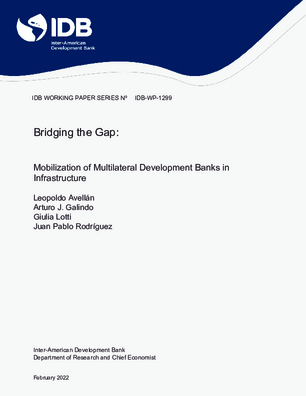Bridging the Gap: Mobilization of Multilateral Development Banks in Infrastructure
Date issued
Feb 2022
Summary
Subject
Finance;
Development Bank;
Capital Flow;
Gross Domestic Product;
Infrastructure Work;
Infrastructure Development;
Emerging Market;
Non-Sovereign Guaranteed Operation;
Investment;
Private Sector;
Income Distribution
JEL code
F21 - International Investment • Long-Term Capital Movements;
F34 - International Lending and Debt Problems;
G15 - International Financial Markets;
H81 - Governmental Loans • Loan Guarantees • Credits • Grants • Bailouts;
O19 - International Linkages to Development • Role of International Organizations
Category
Working Papers
We explore how Multilateral Development Banks (MDBs) can help to fill a large infrastructure financing gap in developing countries by indirectly mobilizing resources from other entities. The analysis focuses on more than 6,500 transactions in 2005-2020 to developing and emerging markets from the Infrastructure Journal database. Using granular data, we analyze the dynamics of flows from different actors to infrastructure at the country-subsector level, and control for a wide range of fixed effects. MDB lending significantly increases the inflows from other sources. Cross-border and domestic resources are mobilized from both the public and the private sectors. Effects exhibit country heterogeneity. Mobilization occurs in countries of all income levels, though it is stronger in low and lower-middle income countries. In countries that use capital controls frequently mobilization effects are undermined. When the global financial crisis of 2008 hit, no difference in mobilization effects was found, unlike the COVID-19 pandemic when mobilization effects were weakened. The findings survive a long battery of robustness checks, and no evidence of anticipation effects is found.
Generative AI enabled




